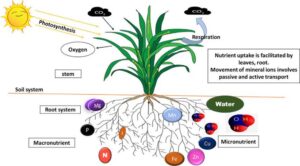Back to: Botany 200 Level
Hello, my brilliant student! How are you doing today? Have you ever wondered how plants get the nutrients they need from the soil? Unlike humans who eat food, plants absorb mineral ions through their roots from the soil. But how do these nutrients move into the plant? This happens through passive and active transport, which are the two main ways ions enter the root cells. Today, we’ll break it down in a way that makes it easy to understand.
Mechanisms of Ion Absorption in Roots (Passive and Active Transport)
Plant roots absorb essential minerals like nitrogen, phosphorus, potassium, calcium, and others in the form of ions (charged particles). These ions move from the soil into the root cells through two main processes:
Passive Transport – No energy is required.
Active Transport – The plant uses energy (ATP) to absorb nutrients.
1. Passive Transport (No Energy Required)
Passive transport occurs when ions move naturally from an area of high concentration (soil) to an area of low concentration (root cells). This is just like when you add sugar to water—it spreads on its own without needing to stir.

Types of Passive Transport:
Diffusion
Ions move freely from the soil into the roots.
Example: If a farmer adds fertiliser to the soil, the dissolved nutrients move into the plant roots through diffusion.
Facilitated Diffusion
Some ions need special protein channels in the root cells to help them move inside.
Example: Potassium (K⁺) and nitrate (NO₃⁻) ions enter through these protein channels.
Osmosis (For Water Movement)
Though not for ions, osmosis helps water move into the roots. Since water carries dissolved nutrients, it indirectly helps in ion absorption.
Key Characteristics of Passive Transport:
✔ No energy required
✔ Ions move from high to low concentration
✔ Happens naturally
2. Active Transport (Energy Required)
Sometimes, the concentration of ions in the soil is lower than in the roots, but the plant still needs them. In this case, the plant uses energy (ATP) to actively move ions into the root cells. This is like pumping water uphill—it requires effort.
How Active Transport Works:
Carrier Proteins and Pumps
Root cells have special carrier proteins that use ATP to pull in nutrients.
Example: The sodium-potassium pump moves ions against their concentration gradient.
Ion Exchange Mechanism
Some ions are exchanged to maintain balance.
Example: Hydrogen (H⁺) ions are released by the roots to exchange with nutrients like calcium (Ca²⁺) or magnesium (Mg²⁺) in the soil.

Endocytosis (For Large Molecules)
The root cell engulfs large nutrient particles by wrapping around them.
Example: Some plants absorb phosphate ions using this method.
Key Characteristics of Active Transport:
✔ Requires energy (ATP)
✔ Moves from low to high concentration
✔ Uses protein pumps and carriers
Why Do Plants Use Both Methods?
Passive transport is fast and easy, but it only works if the soil has enough nutrients.
Active transport ensures the plant gets all the nutrients it needs, even when the soil has low nutrient levels.
Together, these methods help plants absorb minerals efficiently, ensuring proper growth.
Summary
Passive transport moves ions naturally from high to low concentration without energy. It includes diffusion and facilitated diffusion.
Active transport moves ions against the concentration gradient (low to high) and requires energy (ATP).
Both methods help plants absorb essential nutrients from the soil for healthy growth.
Evaluation
- What is the main difference between passive and active transport?
- Why do plants need active transport even though passive transport occurs naturally?
- Give an example of an ion that enters roots through facilitated diffusion.
- What role do carrier proteins play in active transport?
- Why do plants release hydrogen ions (H⁺) into the soil during active transport?
Great job! You now understand how plants absorb nutrients using passive and active transport. Keep up the curiosity—Afrilearn is here to make learning fun and easy! See you in the next lesson!
